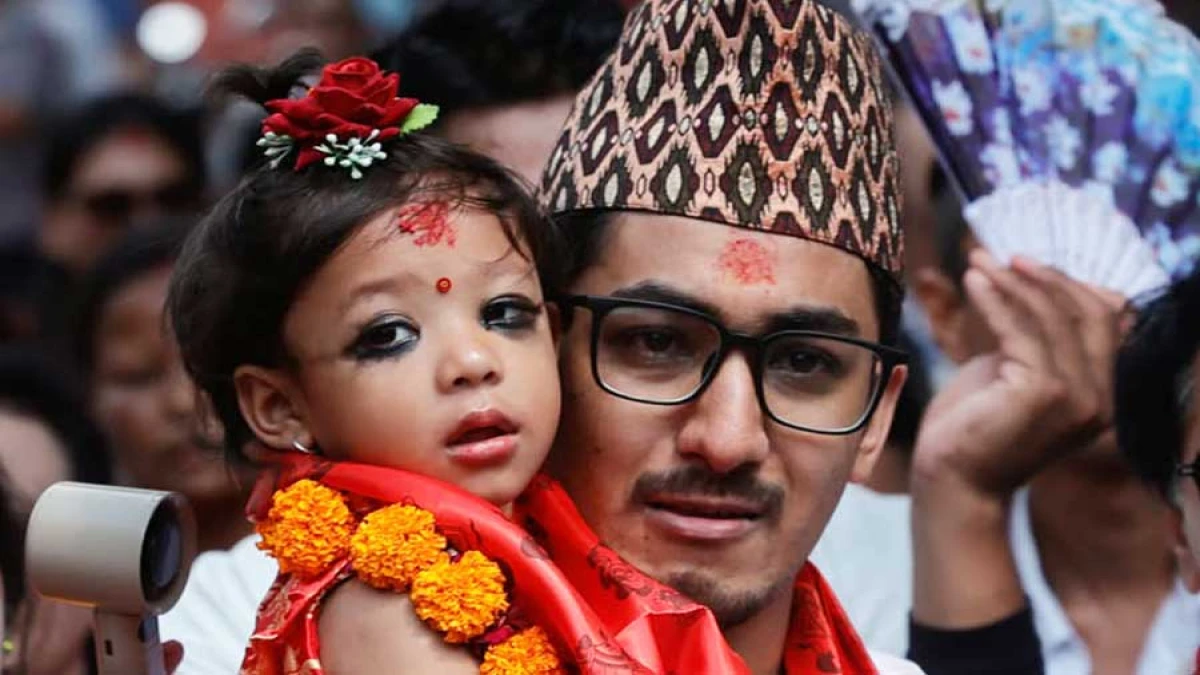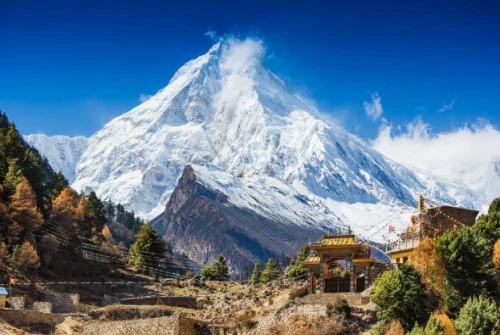In the heart of the Kathmandu Valley lies one of the world’s most extraordinary traditions, a living goddess worshipped by both Hindus and Buddhists alike. Known as the Kumari, this divine figure is believed to be the earthly embodiment of Taleju Bhawani, a powerful Hindu goddess. Unlike other deities worshipped through statues or images, the Kumari is a real girl, living, breathing, and revered as a goddess until she reaches puberty.
The Kumari is not merely a religious icon but a cultural phenomenon, representing Nepal’s deep spiritual heritage. Her presence symbolizes purity, divinity, and the unique harmony between Hinduism and Buddhism. Every year, thousands of devotees and tourists flock to see her at the Kumari Ghar, a magnificent wooden palace in Kathmandu Durbar Square. With her serene face, crimson robes, and kohl-lined eyes, the Kumari radiates an aura of mysticism that captures the imagination of all who behold her. But behind the divine veil lies a fascinating and complex story, a tale of faith, tradition, childhood, and transformation that continues to evolve with modern Nepal.
Introduction – The Divine Child of Nepal
Understanding the Concept of a Living Goddess
The idea of a “living goddess” might sound mythical, yet in Nepal, it is a deeply ingrained spiritual reality. The Kumari is not worshipped for her personal identity but for the divine energy (Shakti) she is believed to possess. She represents the perfect incarnation of feminine power, untouched by sin or impurity. Chosen at a very young age, she becomes the vessel of the goddess Taleju, serving as a bridge between humans and the divine.
Her every gesture is sacred, her smile is seen as a blessing, her tears as an omen. When she appears during festivals, devotees bow down in reverence, seeking protection and good fortune. Even the King of Nepal, before the monarchy was abolished, would seek her blessing before ascending the throne, a symbolic acknowledgment that divine power supersedes royal authority.
Why Nepal Worships a Living Goddess
The worship of the Kumari is rooted in the belief that the divine feminine is the source of all creation. In both Hindu and Buddhist philosophy, Shakti represents the active, dynamic force of the universe. By venerating a living girl as the goddess, Nepal celebrates this life-giving energy in its purest form. It also symbolizes the coexistence of spiritual power and human innocence, a theme deeply embedded in Nepali culture.
Moreover, the Kumari serves as a reminder of Nepal’s ancient spiritual wisdom, a culture that honors not just gods and kings, but the sacredness within human life itself.
Historical Background of the Kumari Tradition
Origins of the Kumari Cult
The Kumari tradition dates back several centuries, believed to have originated in the Malla Dynasty (13th–18th century). The word Kumari comes from the Sanskrit Kaumarya, meaning “virgin” or “unmarried girl.” The practice evolved from tantric rituals where young girls symbolized purity and divine power. Over time, this symbolic worship transformed into the institutionalized veneration of a living goddess.
The Legend of King Jayaprakash Malla and Taleju
According to legend, King Jayaprakash Malla, the last Malla king of Kathmandu, used to play dice with the goddess Taleju in secret. However, one night, the queen discovered them, angering the goddess. She vanished, vowing never to appear again, except in the form of a young virgin girl from the Shakya caste (a Buddhist community). The king, regretful, established the Kumari tradition to honor her. Since then, the living goddess has been chosen from the Newar Shakya families, continuing the sacred bond between the divine and the royal.
The Blend of Hinduism and Buddhism in the Kumari System
One of the most fascinating aspects of the Kumari tradition is its syncretism, a perfect blend of Hindu and Buddhist beliefs. The goddess Taleju is Hindu, yet the chosen girl is from a Buddhist family. Priests from both faiths participate in her rituals, symbolizing Nepal’s long-standing harmony between the two religions. This unity has made the Kumari not just a religious figure, but a symbol of national identity and spiritual inclusivity.
The Selection Process of the Kumari
Criteria for Choosing the Living Goddess
Selecting a Kumari is an elaborate and sacred process that follows strict tantric guidelines. The candidate must be from the Newar Shakya or Bajracharya clan of Kathmandu. Beyond her lineage, she must embody the 32 physical perfections, including a flawless body, dark eyes like a cow, eyelashes like a lion, and a soft voice like a duck. Her horoscope must align with that of the King, and she should never have shed blood or suffered serious illness.
Rituals and Ceremonies in the Selection
The final selection is conducted in a secret ritual by priests of Taleju. One of the most mysterious parts is the “Kalratri” (Black Night) ceremony. During this test, young candidates are placed in a dark room decorated with severed buffalo heads and dancing masked men. The girl who remains calm and unafraid is believed to embody the fearless spirit of the goddess Taleju.
After being chosen, she undergoes purification rites and is officially installed as the Royal Kumari in a grand ceremony. From that day forward, she ceases to be an ordinary child—she becomes divine.
The Role of Astrologers and Priests
Astrologers play a crucial role in verifying the compatibility between the Kumari’s horoscope and that of the nation. Priests, meanwhile, ensure the spiritual legitimacy of the selection process, performing ancient mantras and offerings to invoke the goddess’s presence. The chosen Kumari then begins her sacred life within the Kumari Ghar—the house of the goddess.
Life Inside the Kumari Ghar
Daily Life of the Living Goddess
The Kumari Ghar, situated in Kathmandu’s Durbar Square, serves as both her temple and her home. Once chosen, the Kumari moves in and lives there under the care of her family and attendants. Her days are filled with rituals, prayers, and visits from devotees seeking blessings. She rarely steps outside, only for special festivals and ceremonies. Her every action, from walking to speaking, is regarded as sacred.
She plays, studies, and paints like other children, but lives under spiritual discipline. She wears traditional red robes and intricate gold jewelry, her face adorned with the “Agni chakra,” a symbolic red mark representing the third eye of wisdom.
The Role of Devotees and Caretakers
Caretakers and priests maintain her daily schedule, perform morning and evening rituals, and ensure she remains untouched by impurity. Visitors and devotees come daily, offering coins, flowers, and prayers. Even though she speaks little in public, her expressions are interpreted as divine signs; a smile indicates blessings, while tears foretell misfortune.
Festivals and Public Appearances
The Kumari appears in public only during major festivals like Indra Jatra and Kumari Jatra, where she is carried on a golden chariot through the streets of Kathmandu. Thousands gather to catch a glimpse of her divine face, believing that her blessing brings protection and prosperity.
Symbolism and Spiritual Significance
Kumari as the Manifestation of Taleju
To the people of Nepal, the Kumari is not just a symbolic figure; she is Taleju herself in human form. The goddess Taleju, an incarnation of Durga, embodies power, protection, and purity. By choosing a young, prepubescent girl as her vessel, the Nepalese honor the idea that divine power is best represented through innocence and purity. The Kumari’s calm demeanor and mysterious presence are seen as signs of the goddess’s wisdom and strength.
Every ritual performed around the Kumari reinforces her divinity. When devotees bow before her, they are not simply showing respect to a child; they are seeking direct blessings from the goddess herself. In the eyes of the faithful, she bridges the earthly and spiritual realms, protecting the nation and its people from harm. This belief endows her with an aura of supreme sanctity that few other figures in the world possess.
Representation of Feminine Power (Shakti)
The concept of Shakti, the divine feminine energy that sustains the universe, is at the heart of Kumari worship. In Nepalese tradition, women are considered carriers of sacred energy, and the Kumari represents this in its most divine form. Her presence emphasizes the reverence for feminine power, a philosophy that contrasts sharply with patriarchal norms in many societies.
The Kumari stands as a reminder that true strength lies in compassion, purity, and creation. She embodies the same force that drives the cosmos, making her both a symbol of womanhood and a protector of the nation. In a broader sense, the Kumari’s worship keeps alive the cultural belief that divine power can reside in any human, regardless of age or status.
Spiritual Purity and Divine Presence
Spiritual purity is the cornerstone of the Kumari’s existence. She is believed to be free from sin, untouched by worldly emotions like greed or anger. This purity is why she is seen as fit to host the goddess’s spirit. Even her limited contact with the outside world ensures she remains untainted by negative energies.
Her divine presence is not just metaphorical; it is felt by those who visit her. Many devotees describe a sense of peace, energy, and awe when standing before her. Some claim their wishes were fulfilled after receiving her silent blessing. Whether one believes in the supernatural or not, the Kumari’s aura of sanctity is undeniable; it represents a centuries-old spiritual tradition that continues to inspire faith and wonder.
The Cultural and Religious Importance of Kumari in Modern Nepal
The Kumari’s Influence on Festivals like Indra Jatra
Among the many festivals in Nepal, Indra Jatra holds a special place for the Kumari. This annual festival, celebrated in Kathmandu, honors the Hindu god Indra, but it is the Kumari who becomes the central figure. During the celebration, she is carried in a beautifully decorated golden chariot through the ancient streets of the city.
Thousands of locals and tourists gather to witness this grand procession. The sight of the Living Goddess, dressed in crimson and gold, waving gently to her devotees, is considered one of the most sacred moments of the year. It’s believed that her blessing during this event ensures good fortune, prosperity, and protection from evil for the entire nation.
The festival also reflects Nepal’s ability to blend the divine and the festive, turning spirituality into a communal experience filled with music, dance, and devotion. Through Indra Jatra, the Kumari becomes not just a goddess, but a living embodiment of Nepal’s unity and cultural identity.
Kumari as a National Symbol
Beyond religion, the Kumari has become a national icon of Nepal. Her image graces postcards, documentaries, and cultural exhibitions across the world. She represents the nation’s unique blend of spirituality, heritage, and mysticism. Even after the abolition of Nepal’s monarchy in 2008, the Kumari’s position remained untouched, demonstrating that her significance goes beyond politics or religion.
For many Nepalese, she is a reminder of the country’s sacred roots and a source of pride in their cultural uniqueness. The continued respect and reverence for the Kumari tradition in a rapidly modernizing Nepal prove that some traditions are too deeply embedded to fade away.
The Balance Between Tradition and Modernity
As Nepal grows more connected to the modern world, the Kumari tradition faces new challenges. Critics argue that the practice isolates a young girl from normal life, while supporters see it as a spiritual duty and honor. The Nepalese government has taken steps to ensure that Kumaris receive proper education and healthcare while preserving the sacred customs.
In recent years, former Kumaris have spoken publicly about their experiences, bringing transparency to a tradition that was once shrouded in mystery. This balance between preserving ancient culture and embracing modern values ensures that the Kumari remains relevant, not as a relic of the past, but as a living tradition that evolves with time.
The Transition from Divinity to Humanity
What Happens When the Kumari Menstruates or Bleeds
One of the most defining and delicate moments in the life of a Kumari is when she first menstruates or bleeds due to an injury. According to belief, this marks the departure of the goddess Taleju from her body. At that moment, she ceases to be divine and returns to being an ordinary human. A farewell ritual is performed, and another girl is soon chosen to succeed her.
This transition is both symbolic and emotional. For the Kumari, it marks the end of divine isolation and the beginning of a return to normal life. Yet, after years of being treated as a goddess, adapting to human society can be profoundly challenging.
Life After Being a Kumari
After her reign, the former Kumari returns home, often continuing her education and gradually integrating into social life. Many ex-Kumaris pursue higher studies, professional careers, or marriage. Contrary to old myths that marrying a former Kumari brings bad luck, modern Nepalese society has moved beyond such superstitions.
However, the shift from divine worship to ordinary life can be emotionally taxing. Imagine being revered by thousands, only to suddenly become just another face in the crowd. For some, this transition can feel like a loss of identity. Yet, many ex-Kumaris describe it as a journey of rediscovering humanity, learning to live freely, laugh openly, and reconnect with the world outside the temple walls.
Challenges Faced by Former Kumaris
Former Kumaris often face difficulties adjusting to the social world after years of isolation. Social reintegration, education gaps, and emotional adjustment are major hurdles. Some also struggle with health issues due to limited physical activity during their divine years. However, organizations and the Nepalese government have started providing psychological counseling, education, and social support to help them transition smoothly.
Despite these challenges, former Kumaris hold a special place in society. They are respected for their sacred past and often serve as symbols of resilience and cultural pride. Their stories highlight both the beauty and complexity of being chosen as a living goddess.
The Psychological and Social Dimensions
Emotional Impact on a Child Goddess
Becoming a Kumari at such a young age can be both a blessing and a burden. While the honor is immense, the role can be emotionally isolating. The child lives in an environment where she is treated as divine, no one speaks to her casually, and her every move is watched with reverence. This can limit her ability to form normal friendships or experience an ordinary childhood.
However, it’s important to note that many Kumaris are cared for with deep love and respect by their families and attendants. They are provided with education and entertainment within their residence. Yet, the emotional weight of being worshipped as a goddess can still create confusion in a child’s mind, especially when the divine role ends.
Social Reintegration and Education
Education is a crucial part of reintegrating former Kumaris into society. In the past, they had limited access to formal schooling, but modern reforms have changed that. Now, Kumaris are often taught privately within the Kumari Ghar by tutors or monks. After leaving their divine role, they continue their education in regular schools, where they face the challenge of adapting to normal student life.
The government and NGOs have made significant efforts to bridge the gap between spiritual duty and human development. Many former Kumaris have gone on to complete higher education and become advocates for women’s rights, preserving the dignity of their tradition while contributing to Nepal’s modern society.
The Role of Family and Society
Families of Kumaris play a crucial role in their emotional well-being. They act as both guardians and interpreters between the divine and human worlds. Society, too, holds a collective responsibility to respect the tradition without isolating the child behind it. Thankfully, attitudes are shifting toward compassion, understanding, and balance.
The Kumari system is no longer seen purely as a religious spectacle but as a sacred cultural responsibility shared by the entire community. This evolving understanding ensures that the tradition continues in a more humane and enlightened way.
Controversies and Criticisms
Ethical Concerns of Worshipping a Child
Despite its deep spiritual significance, the Kumari tradition has faced criticism from both local and international observers. The most common concern centers around the ethics of worshipping a child. Critics argue that treating a young girl as a divine being may deprive her of a normal childhood, friends, education, and emotional freedom. Living within the confines of the Kumari Ghar, she has limited physical activity and interaction with the outside world.
However, defenders of the tradition emphasize that Kumaris are not exploited but honored and revered. They are given utmost respect, care, and devotion by priests and caretakers. Many former Kumaris have spoken out, explaining that they did not feel abused or neglected but rather privileged to be part of a sacred duty. Still, the balance between spirituality and child welfare remains a point of global discussion.
Legal and Human Rights Debates
In 2007, Nepal’s Supreme Court addressed the issue of the Kumari tradition after child rights activists filed petitions arguing that the practice violated basic human rights. The court’s verdict was historic; it allowed the continuation of the tradition but ordered the government to ensure the Kumaris’ education, health, and overall well-being. This decision marked a turning point, ensuring that the tradition would survive but under better conditions for the child goddess.
Since then, Kumaris have been provided tutors, healthcare, and emotional counseling. They are now allowed to pursue schooling even during their divine years. This reform has made the institution more humane, showing how ancient practices can adapt to modern principles of child rights and dignity.
Modernization vs. Preservation of Tradition
The question of modernization versus preservation looms large. Some argue that the Kumari tradition belongs to a bygone era and should evolve with time, while others insist it must remain untouched as part of Nepal’s spiritual and cultural heritage. The challenge lies in finding a middle path, one that respects ancient beliefs without compromising a child’s freedom and well-being.
The world is changing rapidly, yet the Kumari’s serene presence amidst the chaos of Kathmandu reminds everyone of Nepal’s eternal link between faith and identity. The living goddess may be young, but her significance transcends generations, bridging the past, present, and future of the nation.
The Future of the Kumari Tradition
Governmental and Cultural Preservation Efforts
Recognizing the Kumari’s importance, both spiritually and culturally, the Nepalese government and local organizations have taken measures to preserve and protect the tradition. The Kumari Ghar has been maintained as a cultural heritage site, and new guidelines ensure that Kumaris receive education, medical care, and social interaction.
Cultural preservation groups have also begun documenting the history, rituals, and experiences of the Kumari to ensure that this unique heritage is passed on responsibly. Moreover, schools and universities now teach about the Kumari system as part of Nepal’s intangible cultural heritage, fostering respect for the tradition among younger generations.
Changing Roles of Kumari in the 21st Century
In the modern age, the Kumari is not just a figure of devotion but also a symbol of female empowerment. Her role has evolved from a passive divine presence to a living emblem of Nepalese identity and resilience. Former Kumaris have begun sharing their stories publicly, dispelling myths and encouraging reforms to make the practice more balanced.
With greater awareness and modern education, today’s Kumaris are learning that divinity does not end with their reign, it continues in the strength, grace, and wisdom they carry forward. Many of them become teachers, social workers, and advocates for cultural preservation, redefining what it means to be a living goddess in today’s world.
Global Recognition and Tourism Impact
The Kumari tradition has gained international recognition as one of the most unique cultural phenomena on Earth. Tourists from all over the world visit Kathmandu to catch a glimpse of the living goddess, contributing to Nepal’s tourism economy. The sight of the Kumari appearing at the window of her palace during festivals remains one of the most iconic moments for visitors.
However, this fame also brings challenges, balancing sacred worship with public curiosity. Authorities are careful to maintain the sanctity of the rituals, ensuring that tourism does not turn the divine into a spectacle. Still, the Kumari continues to serve as a powerful ambassador of Nepal’s spirituality, drawing attention to the nation’s deep respect for divine femininity.
Conclusion
The Kumari of Nepal is not just a goddess in flesh and blood; she is the living soul of a nation steeped in devotion and heritage. Her story is one of mystery, reverence, and transformation, where a child becomes divine, and then human again. The tradition beautifully illustrates Nepal’s ability to blend faith and culture, showing that spirituality can exist harmoniously alongside modern values.
In a world where many traditions fade under the weight of modernization, the Kumari stands resilient, a living reminder that divinity still walks among humans. Whether seen through a religious, cultural, or symbolic lens, the Kumari represents the eternal connection between the human and the divine, between innocence and power, and between the past and the future.
FAQs
1. Who is the current living Kumari of Nepal?
The current Royal Kumari of Kathmandu is chosen through a sacred process, and her identity is announced publicly after her enthronement. As of recent years, she resides in the Kumari Ghar in Kathmandu Durbar Square, performing her spiritual duties and receiving visitors who come to seek her blessings.
2. How old is a Kumari when chosen?
A Kumari is typically chosen between the ages of 3 and 5 years old. She remains the living goddess until she experiences her first menstruation, loses a tooth, or bleeds for any reason, marking the end of her divine reign.
3. Can the Kumari speak or attend school?
Traditionally, the Kumari was expected to remain mostly silent in public, with her expressions interpreted as divine messages. However, modern Kumari receive private education within the Kumari Ghar, and recent reforms now allow them to attend regular schools after their tenure.
4. What happens after she stops being a Kumari?
After her divine period ends, the former Kumari returns to her family and reintegrates into normal life. She continues her education and can pursue any profession or marriage. Former Kumaris are respected figures in Nepalese society for their spiritual past.
5. Can foreigners meet the Kumari?
Yes, visitors can see the Kumari at her residence in Kathmandu Durbar Square. However, audiences must maintain silence, avoid touching her, and respect her sacred status. Photography is not allowed unless explicitly permitted.
Final Thoughts
The legend of the Kumari reminds us that spirituality can live and breathe through a child’s heart, that the divine is not distant but woven into human life itself. The Living Goddess of Nepal remains a testament to purity, faith, and feminine divinity, standing tall in a rapidly changing world.




